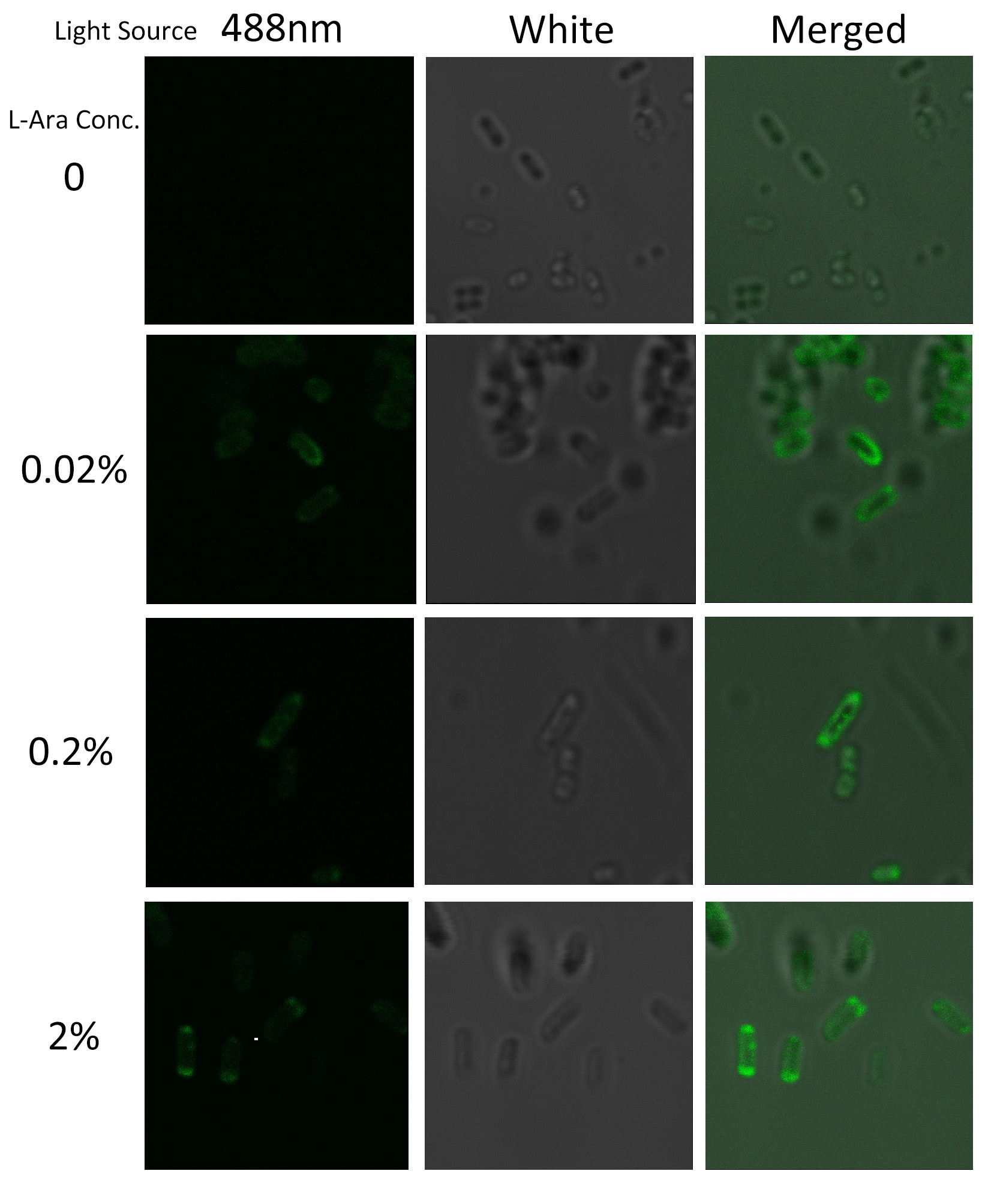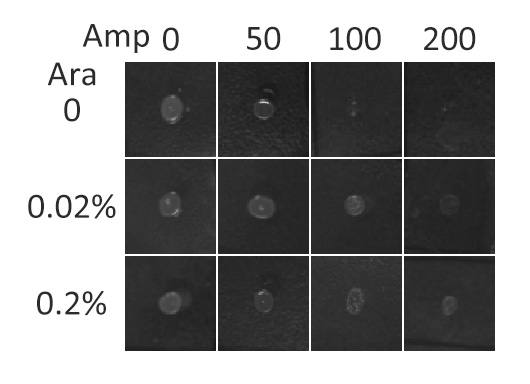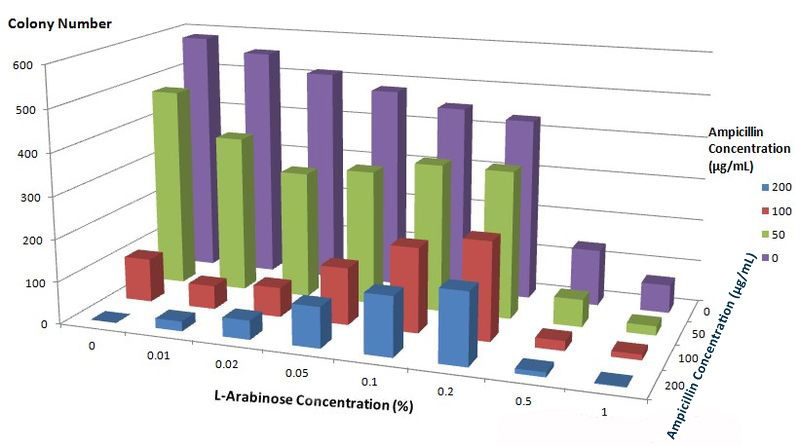Team:SJTU-BioX-Shanghai/Project/project1.1
From 2012.igem.org
(Difference between revisions)
AleAlejandro (Talk | contribs) (→Protein Construction) |
AleAlejandro (Talk | contribs) (→Membrane Localization) |
||
| Line 49: | Line 49: | ||
SsDsbA is the signal recognition particle (SRP)-dependent signaling sequence of DsbA. SsDsbA-tagged proteins are exported to the periplasm through the SRP pathway. With ssDsbA fused to the N-terminus, engineered membrane proteins are expected to be anchored onto inner membrane of ''E.coli''. | SsDsbA is the signal recognition particle (SRP)-dependent signaling sequence of DsbA. SsDsbA-tagged proteins are exported to the periplasm through the SRP pathway. With ssDsbA fused to the N-terminus, engineered membrane proteins are expected to be anchored onto inner membrane of ''E.coli''. | ||
| + | |||
| + | To justify the localization ability of fusion membrane proteins mentioned above, we constructed a fusion protein called '''BlaLG'''. β-lactamase is fused to the N-terminus of Lgt and GFP is fused to the C-terminus of Lgt. The fusion protein in under control of araBAD promoter. | ||
| + | [[Image:12SJTU-project1-1.png|thumb|500px|center|''Fig.1'' :Details of fusion protein BlaLG for membrane localization]] | ||
<br> | <br> | ||
| Line 57: | Line 60: | ||
===Fluorescence Test=== | ===Fluorescence Test=== | ||
| + | |||
To visualize the localization of BlaLG fusion protein, we adopted fluorescence test. GFP fused to the C terminus of BlaLG enables us to have a closer look at where the membrane proteins are localized. Under laser confocal microscope, we can observe the location of the fluorescence, thus to confirm the exact subcellular localization of the fusion protein. | To visualize the localization of BlaLG fusion protein, we adopted fluorescence test. GFP fused to the C terminus of BlaLG enables us to have a closer look at where the membrane proteins are localized. Under laser confocal microscope, we can observe the location of the fluorescence, thus to confirm the exact subcellular localization of the fusion protein. | ||
| Line 70: | Line 74: | ||
===Antibiotics Test=== | ===Antibiotics Test=== | ||
| - | |||
In this section, we test the membrane localization ability of fusion membrane protein by observing host cells' growth phenotype under different level of Ampicillin. | In this section, we test the membrane localization ability of fusion membrane protein by observing host cells' growth phenotype under different level of Ampicillin. | ||
| - | |||
| - | |||
β-lactamase,a bacterial enzyme which must be exported to the periplasm in order to confer significant resistance to β-lactam antibiotics, such as ampicillin. Note that N-terminus of Lgt faces the periplasm and C-terminus faces the cytoplasm。 Hence, if our fusion membrane protein is correctly anchored to membrane,β-lactamase is expected to be functional and host cells should be able to grow on culture media containing ampicillin. (Skretas and Georgiou 2010) | β-lactamase,a bacterial enzyme which must be exported to the periplasm in order to confer significant resistance to β-lactam antibiotics, such as ampicillin. Note that N-terminus of Lgt faces the periplasm and C-terminus faces the cytoplasm。 Hence, if our fusion membrane protein is correctly anchored to membrane,β-lactamase is expected to be functional and host cells should be able to grow on culture media containing ampicillin. (Skretas and Georgiou 2010) | ||
| Line 80: | Line 81: | ||
[[Image:12SJTU_AntiTest.jpg|thumb|400px|center|''Fig.2'' :Growth phenotypes of ''E. coli'' cells expressing BlaLG on LB agar media with concentration of inducer L-arabinose from 0 to 0.2%. We increased the concentration of ampicillin from 0 to 200 (μg/ ml).Bacteria carrying BlaLG were able to grow at ampicillin concentration of 200 μg/ ml with induction]] | [[Image:12SJTU_AntiTest.jpg|thumb|400px|center|''Fig.2'' :Growth phenotypes of ''E. coli'' cells expressing BlaLG on LB agar media with concentration of inducer L-arabinose from 0 to 0.2%. We increased the concentration of ampicillin from 0 to 200 (μg/ ml).Bacteria carrying BlaLG were able to grow at ampicillin concentration of 200 μg/ ml with induction]] | ||
| - | ''Fig. | + | ''Fig.4'' showed that our fusion protein has been correctly localized to membrane. Besides, a very low L-arabinose concentration at 0.02% is already enough to induce sufficient amount of membrane protein. |
| Line 86: | Line 87: | ||
| - | [[Image:12SJTU_Antibioticstest2.jpg|thumb|600px|center|''Fig. | + | [[Image:12SJTU_Antibioticstest2.jpg|thumb|600px|center|''Fig.5'' :Growth condition of ''E. coli'' cells expressing BlaLG on LB agar media with concentration of L-arabinose and Ampicillin. Single colony is picked and cultivated at 37℃ until OD value reaches 0.7. Bacteria cultures are diluted by 1:100000 and coated onto plates containing different concentration of L-Arabinose and Ampicillin. Growth condition is measured through counting colonies on plates.]] |
The result apparently showed that at L-Arabinose concentration of 0.1% and 0.2%, more bacteria could grow on high concentration of Ampicllin. Thus, L-Arabinose concentration of 0.1% and 0.2 best suits membrane protein expression in Project ''Membrane Magic''. | The result apparently showed that at L-Arabinose concentration of 0.1% and 0.2%, more bacteria could grow on high concentration of Ampicllin. Thus, L-Arabinose concentration of 0.1% and 0.2 best suits membrane protein expression in Project ''Membrane Magic''. | ||
Revision as of 14:20, 26 September 2012
 "
"






